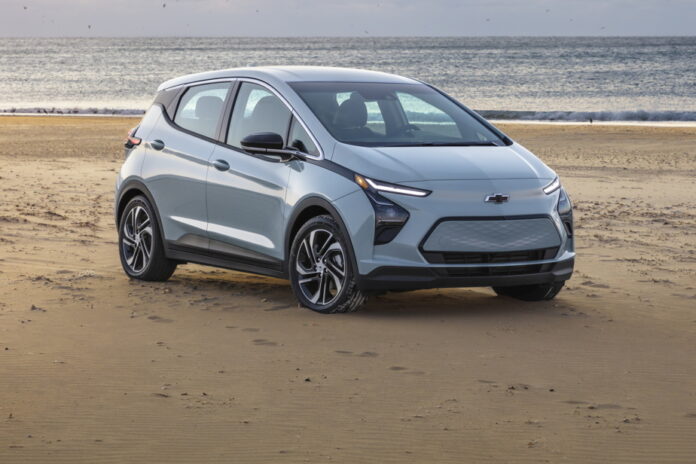For many households, the prices of electric vehicles constitute a barrier to their adoption, a perception confirmed by a survey carried out at the beginning of the year by the firm KPMG. To this bill, we must invariably add skyrocketing interest rates as well as the cost of acquiring and installing a home terminal. Their democratization nevertheless makes certain models more accessible. Here is a selection of vehicles with a starting price below $50,000*.
Although its production will end in a few weeks to leave its assembly plant for electric versions of the Chevrolet Silverado and GMC Sierra pickup trucks, the Chevrolet Bolt deserves a mention here. The most affordable electric model at the moment, this subcompact seduces with its good range (417 km) as well as its format perfectly suited to a city lifestyle. Its interior is also very well designed to allow daily use. Now let’s hope that its descendant, which will benefit from a latest generation Ultium battery, maintains its affordability alongside an electric Chevrolet Equinox promised at $35,000.
Considered the first mass-market electric car to see the light of day, the Nissan Leaf has been rolling out in Canada since the fall of 2011. Its second generation is still an interesting offering due to its accessibility, but is becoming rather dated. The entry-level SV livery is limited in power to 147 hp and range to just 240 km due to its still smaller air-cooled battery (40 kWh) compared to the SV Plus. The latter can travel 342 km thanks to its 62 kWh reserve and is faster with its 214 hp, a bonus which increases the bill to $47,498.
While waiting for the prices of the electric version of the latest vintage of the Kona electric scheduled for next year, we can only fall back on the entry price of the 2023 version. At $44,599, this subcompact SUV with front-wheel drive is a bargain due to its 415 km range achieved by means of a 64 kWh battery. Its 201 hp ensures acceptable enthusiasm and its charging power limited to 100 kW allows compatibility with numerous Electric Circuit terminals. Note that this hardware will be reused in the new generation of the model.
A little-known model in Hyundai-Kia’s electric sector, the electric Kia Niro debuted in 2022 as a 2023 model in a much more modern form. Comfortable and equipped with a spacious interior that has greatly matured, this small SUV advances 407 km to support an interesting exterior design defined by its boomerang side stripes. Mechanically, it has the same motor-battery group as the electric Kona, with a power of 201 hp and 64.8 kWh in reserve. But unlike this model, the Kia Niro is not equipped with a heat pump to reduce energy consumption.
Undoubtedly one of the most versatile and competitive electric models currently available, the Ioniq 5 comes in at just under $50,000 for entry-level pricing. In exchange for $49,000, the buyer is offered a rear-wheel drive livery with a 168 hp engine and a 58 kWh battery, a duo supporting a range of 358 km. If you have an extra $3,000 to spare, the extended-range Preferred version is arguably a better deal with 300 miles to spare.
The most affordable electric compact SUV, the Toyota bZ4X represents a timid entry into the all-electric market for the Japanese manufacturer. Its estimated 406 km of range for the front-wheel drive version is largely dependent on the weather and the use of heating or air conditioning. Its integrated charger limited to a power of 6.6 kW also makes the charging time rather high on a residential terminal. Its interior still remains spacious. We cannot keep quiet about its accessibility, but Toyota is already talking about a new electric platform which will make this bZ4X quickly outdated.
After a rough start due to supply problems, the ID.4 returned to a more acceptable pace thanks to the move of production to Chattanooga, Tennessee. This was accompanied by the offering of a more affordable version with a 62kWh battery limiting the range to a measly 336km. This livery is $4000 cheaper than the 82kWh battery variant pushing the range to 443km. However, all examples of these liveries are sold out by 2023.
To benefit from the Quebec government’s incentive measure of $7,000, the vehicle must have a suggested retail price below $65,000 in addition to being registered for at least 12 months, if it is for personal use. If you want to benefit from the full discount when renting, it must be spread over at least 48 months.
On the federal side, the $5,000 incentive measure is applicable to vehicles whose base price does not exceed $55,000. The best-equipped liveries of these models have a cap of $65,000. In terms of pickup trucks, SUVs and minivans, this framework is respectively at $60,000 for the entry bill and $70,000 for the maximum price of the variation. Like the Quebec approach, you must contract a rental of at least 48 months to benefit from full subsidies.
Note that these two incentive measures are deducted after the application of taxes, which somewhat reduces their real scope.















